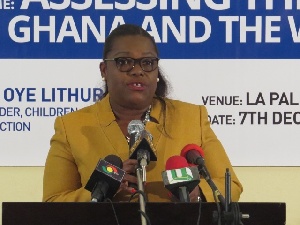Nana Oye Lithur, Minister of Gender, Children and Social Protection, has called for the formulation of a 10-year strategic plan to serve as a guide for activities towards the total elimination of teenage pregnancy in Ghana.
Nana Oye who was addressing a national stakeholders conference on “Assessing the Situation in Ghana and the Way Forward”, in Accra on Monday, said the high rate of teenage pregnancy was unacceptable and very dangerous for achieving meaningful and sustainable development.
She said a long term strategic plan could therefore be developed through strengthened stakeholder collaborations, to critically access the current situation, looking at the gaps in existing interventions on the provision of Adolescence and Reproductive Health services and other activities, in order to achieve coherent and sustainable intervention for eliminating teenage pregnancy.
The conference, which was organised by the Ministry of Gender, Children and Social Protection, targets both governmental and Non-governmental Organisations (NGOs), Civil Society Organisational and development partners, whose work relate to female reproductive health, education and development issues.
According to Nana Oye, teenage pregnancy has become a major global health concern with an alarming figure of approximately 16 million adolescent girls aged between 15 to 19 years giving birth each year, and this constitutes about 11 per cent of all births worldwide.
Nana Oye said the negative effects of teenage pregnancy include the fact that many young girls especially those in the rural communities drop out of school, as research has shown that lack of sexual and reproductive health education leads to a high rate of teenage pregnancy, unsafe abortions and an increase in Sexually Transmitted Infections among others.
She said there were also gaps such as programmes which tend to focus heavily on information provision rather than on services, little research on the disparity of teenage pregnancy among regions and districts, and also less concentration on educational research and policy development that focuses on sexual and reproductive health issues.
She said increased collaboration with government, Non-governmental Organisations (NGOs), and Development Partners, was needed to bridge the existing gaps in current programming aimed at addressing the increasing menace of teenage pregnancy.
She further suggested ways such as the prevention of unintended conceptions, rather than reducing pregnancy levels through higher abortion rates; strengthening secondary preventive efforts through education, employment and support interventions aimed at helping the mother and child, particularly single mothers; and integrating preventive efforts with other related services, as some of the best ways to combat the phenomenon.
She also called for intensified efforts towards the provision of sex education before young people become sexually active, with open attitudes and a positive approach to sexual health and relationships, were key to addressing the problem.
Nana Oye pledged the Ministry’s commitment to working with all government partners and NGOs, to overcome the problem.
Professor Kofi Awusabo-Asare, a Senior Lecturer at the University of Cape Coast, who gave an overview of teenage pregnancy in Ghana, said Ghana Demographic and Health Survey of 2014, indicates that 14 per cent of adolescent women aged between 15 and 19 years are mothers or pregnant with their first child.
However, regional assessment of teenage pregnancy shows that the Upper East, Volta, Brong Ahafo, Central and Eastern regions have the highest regional rates of 14 per cent and above, between 2012 and 2014, and of these regions the Upper East region has the highest national prevalence rate of teenage pregnancy of 15 per cent, with the Northern region recording the lowest prevalence rate of 4.4 per cent.
He said the dangers of teenage pregnancy included high mortality and morbidity rates, low infant birth rates and protracted generational poverty as lack of skills and support for these girls may lead to huge economic burden on government, society and the individuals themselves.
Regional News of Tuesday, 8 December 2015
Source: Ministry for Gender

















